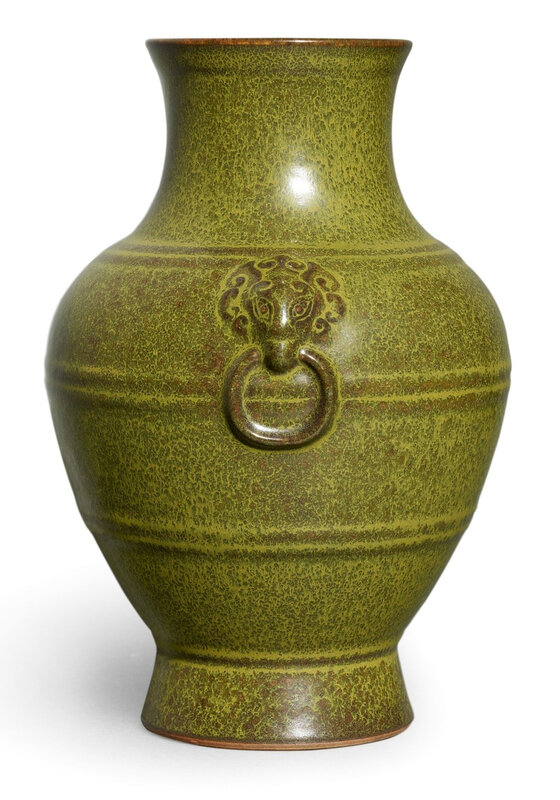the ovoid body rising from a splayed foot to swelling shoulders surmounted by a waisted neck flaring at the rim, flanked by two moulded mask and mock ring handles, encircled around the body with horizontal ribs, applied overall with a speckled two-toned green, incised to the base with a four-character seal mark, Japanese wood box.
Provenance: Sotheby's Hong Kong, 29th April 1997, lot 587.
Note: The current vase demonstrates the ever-improving technical ability of the Jingdezhen potters during the Yongzheng period. This included the re-creation of completely different media in ceramics. Wood, lacquer, metal and stone became popular materials to be imitated, amongst which bronze simulations demanded skills far more challenging and ambitious than what was normally expected. The opaque and mottled glaze on this piece was achieved through the high concentration of iron oxide in the glaze, and required to be fired in a weak reduction atmosphere and slowly cooled to result in this unique patina that resembles bronze.
Compare a Yongzheng teadust-glazed vase of similar size and form included in the Illustrated Catalogue of Ch'ing Dynasty Porcelain in the National Palace Museum, vol. I, 1980, pl. 152; and one from the collection of the British Rail Pension Fund sold in these rooms, 16th May 1989, lot 54. See also a flambé-glazed vase of this form sold in these rooms, 10th April 2006, lot 1604.
Sotheby's. Monochrome II, 9 October 2020, Hong Kong

/https%3A%2F%2Fprofilepics.canalblog.com%2Fprofilepics%2F1%2F0%2F100183.jpg)
/https%3A%2F%2Fstorage.canalblog.com%2F03%2F02%2F119589%2F96711876_o.jpg)
/https%3A%2F%2Fstorage.canalblog.com%2F11%2F31%2F119589%2F94773502_o.jpg)
/https%3A%2F%2Fstorage.canalblog.com%2F20%2F83%2F119589%2F94772815_o.jpg)
/https%3A%2F%2Fstorage.canalblog.com%2F26%2F72%2F119589%2F75604929_o.jpg)
/https%3A%2F%2Fstorage.canalblog.com%2F59%2F60%2F119589%2F26458628_o.jpg)





/image%2F1371349%2F20240425%2Fob_e64568_440367995-1657703268333019-41468471616.jpg)
/http%3A%2F%2Fstorage.canalblog.com%2F63%2F62%2F119589%2F129821675_o.jpg)
/http%3A%2F%2Fstorage.canalblog.com%2F43%2F82%2F119589%2F129801198_o.png)
/http%3A%2F%2Fstorage.canalblog.com%2F40%2F90%2F119589%2F129784381_o.jpg)